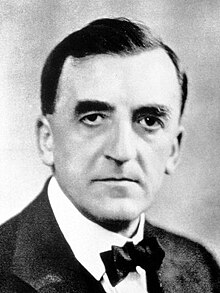Major Greenwood
Major Greenwood | |
|---|---|
 Major Greenwood | |
| Born | 9 August 1880 Shoreditch, London, England |
| Died | 5 October 1949 (aged 69) |
| Nationality | British |
| Awards | Weldon Memorial Prize (1926) |
| Scientific career | |
| Fields | Epidemiology |
Major Greenwood
Biography
Major Greenwood junior was born in
He went to work as a demonstrator for the physiologist
The Royal Society awarded the Buchanan Medal to Greenwood in 1927,[4] and elected him a Fellow in 1928.[1] The election certificate stated
Engaged in medical research. Has applied the statistical method to the elucidation of many problems of physiology, pathology, hygiene and epidemiology. Is the author, or joint author, of more than sixty papers dealing with these applications, including important contributions to the experimental study of epidemiology (Journ Hyg, 24, 1925, Greenwood and Topley; ibid, 25, 1926, Greenwood, Newbold, Topley and Wilson). Has done much to encourage and develop the use of modern statistical methods by medical laboratory investigators, and, as Chairman of the Medical Research Council's Statistical Committee, to secure the adequate planning and execution of field investigations.
He was elected
in Gold in 1945.Greenwood produced a large body of research, was the first holder of important positions in modern medical statistics and wrote extensively on the history of his subject, but as Austin Bradford Hill wrote in his obituary, "in the future, it may well indeed seem that one of his greatest contributions, if not the greatest, lay merely in his outlook, in his statistical approach to medicine, then a new approach and one long regarded with suspicion. And he fought this fight continuously and honestly—for logic for accuracy, for ‘little sums.’"
His name is attached to the Greenwood formula for the variance or standard error (SE) of the Kaplan–Meier estimator of survival.[6][7][8]
A statistical method invented by Major Greenwood in a statistical study of infectious diseases[9] is still used in present-day research. The Greenwood statistic was used to discover that there is some kind of order in the placement of genes on the chromosomes of living things[10] and this inspired a new look at epigenetics, which is now considered to be as important as genetics in how living organisms develop and evolve.
Greenwood lived at
Publications
- Greenwood, M. (1904). "A First Study of the Weight, Variability, and Correlation of the Human Viscera, with Special Reference to the Healthy and Diseased Heart". Biometrika. 3: 63–83. .
- Greenwood, M. (1910). Physiology of the special senses. London: E. Arnold.[11]
- Greenwood, M; Yule, G. U. (1915). "The Statistics of Anti-typhoid and Anti-cholera Inoculations, and the Interpretation of such Statistics in general". Proceedings of the Royal Society of Medicine. 8 (Sect Epidemiol State Med): 113–94. PMID 19978918.
- Greenwood, Major & Udny Yule, G. (1920). "An Inquiry into the Nature of Frequency Distributions Representative of Multiple Happenings with Particular Reference to the Occurrence of Multiple Attacks of Disease or of Repeated Accidents". Journal of the Royal Statistical Society. 83 (2): 255–279. JSTOR 2341080.\
- Edgar L. Collis and Major Greenwood. The health of the industrial worker. 1921
- Cripps, L, Greenwood, M. and Newbold, E (1923). "A Biometric Study of the Inter-relations of `Vital Capacity' stature, stem length and weight in a Sample of Healthy Male Adults". Biometrika. 14: 3–4. doi:10.2307/2331816. JSTOR 2331816.
- Greenwood, M.; Newbold, E (1923). "On the Estimation of Metabolism from Determination of Carbon Dioxyde Production and on Estimation of External Work from Respiratory Metabolism". J. Hygiene. 21: 3–4. doi:10.1017/s0022172400031624. PMC 2167379 .
- Greenwood, M.; Newbold, E (1927). "Practical Applications of Statistics of Repeated Events, particularly to Industrial Accidents". J. Royal Stat. Society. 90: 487–547. doi:10.2307/2341203. JSTOR 2341203.
- Major Greenwood. The natural duration of cancer. London, England: His Majesty’s Stationery Office, Reports on Public Health and Medical Subjects, No. 33. 1926
- Major Greenwood. Epidemics and crowd-diseases: an introduction to the study of epidemiology. 1935
- Major Greenwood. Medical statistics from Graunt to Farr: the Fitzpatrick lectures for the years 1941 and 1943. 1948
References
- ^ S2CID 162020251.
- ^ a b Burke's Landed Gentry, 18th ed., vol. I, 1965, pg 338-343, 'Greenwood formerly of Haddenham' pedigree
- JSTOR 2341811.
- ^ "Buchanan archive winners 1957–1897". The Royal Society. Retrieved 22 March 2011.
- ^ "Royal Statistical Society Presidents". Royal Statistical Society. Archived from the original on 17 March 2012. Retrieved 6 August 2010.
- ^ Greenwood, Major (1926). "The natural duration of cancer". Reports on Public Health and Medical Subjects. 33. London: Her Majesty's Stationery Office: 1–26.
- JSTOR 2281868.
- ^ Kaplan, Edward L. in a retrospective on the seminal paper in "This week's citation classic". Current Contents 24, 14 (1983). Available from UPenn as PDF.
- PMID 20256635.
- PMID 17397552.
- S2CID 38219110.
Further reading
- Royal Society Certificate of Election and Candidature[permanent dead link]
- A. B. H.; William Butler (1949) "Obituary: Major Greenwood", Journal of the Royal Statistical Society. Series A (General), 112, 487–489.
- McKinlay, P. L. (1951). "Major Greenwood, 1880-1949". Biometrika. 38 (1–2): 1–3. PMID 14848107.
- Anne Hardy; Eileen Magnello (2002) "Statistical methods in epidemiology: Karl Pearson, Ronald Ross, Major Greenwood and Austin Bradford Hill", 1900–1945 Soz Praventiv Med; 47(2): 80–89.
- Farewell, V.; Johnson, T.; Armitage, P. (2006). "'A memorandum on the Present Position and Prospects of Medical Statistics and Epidemiology' by Major Greenwood". Statistics in Medicine. 25 (13): 2161–77. PMID 16755605.
- J. Rosser Matthews (1995) Quantification and the Quest for Medical Certainty, Princeton, Princeton University Press.
- "Greenwood, Major". doi:10.1093/ref:odnb/51797. (Subscription or UK public library membershiprequired.)
